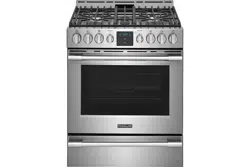Documents: Go to download!
User Manual
- User Manual - (English)
- Owner's Guide - (French)
- Quick Start Guide - (English)
- Specification Sheet - (English)
- Spec Sheet (web) - (English)
- Installation Instruction - (Spanish)
- Installation Instruction (English, Spanish, French) - (English)
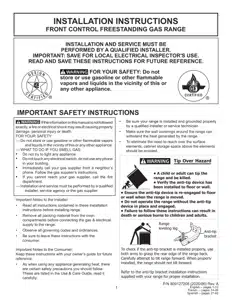
- BEFORE SETTING OVEN CONTROLS
- SETTING OVEN CONTROL
- BEFORE YOU CALL
Table of contents
User manual Range
BEFORE SETTING OVEN CONTROLS
Oven Vent Location
The oven is vented as shown below. When the oven is on, warm air is released through the vent. This venting is necessary for proper air circulation in the oven and good baking results. Do not block oven vent. Never close off the openings with aluminium foil or any other material. Steam or moisture may appear near the oven vent. This is normal.
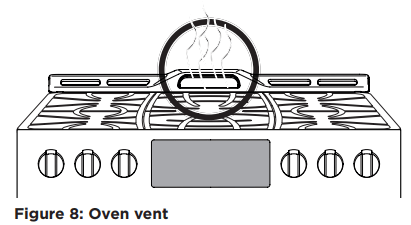
WARNING
Protective Liners — Do not use aluminum foil or any other material or liners to line the oven bottom, walls, racks or any other part of the range. Doing so will alter the heat distribution, produce poor baking results, and possibly cause permanent damage to the oven interior. Improper installation of these liners may result in risk of electric shock or fire. During self clean, temperatures in the oven will be hot enough to melt foil.
CAUTION
Always use pot holders or oven mitts when using the oven. When cooking, the oven interior, oven exterior, oven racks, and cooktop will become very hot which can cause burns.
Remove all oven racks before starting a self clean cycle. If oven racks are left inside the oven during a cleaning cycle, the slide ability of the oven racks may be damaged and all of the oven racks will lose their shiny finish.
To prevent possible damage to the oven, do not attempt to close the oven door until all the oven racks are fully positioned back inside the oven cavity
Types of Oven Rack
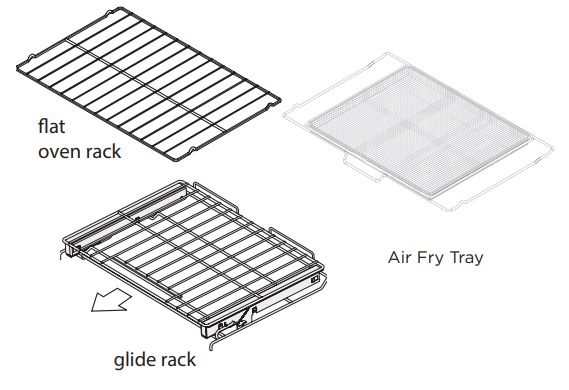
Removing, Replacing, and Arranging Racks
Always arrange the oven racks when the oven is cool.
To remove - Pull the oven rack straight forward until it reaches the stop position. Lift up front of oven rack slightly and slide out.
To replace - Place the oven rack on the rack guides on both sides of oven walls. Tilt the front of oven rack upward slightly and slide the oven rack back into place. Be sure oven racks are level before using.
Removing and Replacing the Glide Racks
The fully extendable Glide rack makes food preparation easier. This oven rack has glide tracks that allow the rack to be pulled away from the oven without rubbing the sides of the oven wall.
To remove - Make sure the baking rack is in the closed position. Using one hand, reach through handle opening and grasp both the upper and lower portions of the glide rack
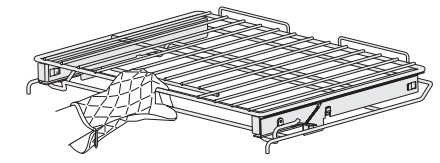
While holding both sections, pull the glide rack out of the oven until the stop position is reached

Using both hands, lift up the front of the rack slightly and continue to pull the rack away from the oven. Be sure to grasp both upper and lower rack portions together when removing or handling the glide rack.
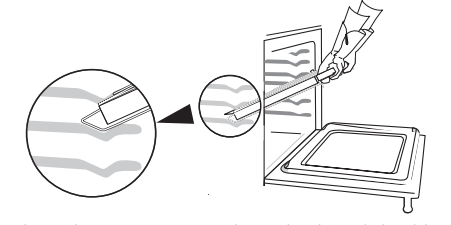
The rack portions move independently and should be held together when removing and replacing.
To replace - Make sure the baking rack is in the closed position. Grasp both upper and lower portions of glide rack. Lift and hold the rack level between the oven cavity walls. Tilt the front of the rack upward slightly and slide the rack completely into position.
To prevent possible damage to the oven, do not attempt to close the oven door until all the oven racks are fully positioned back inside the oven cavity
SETTING OVEN CONTROL
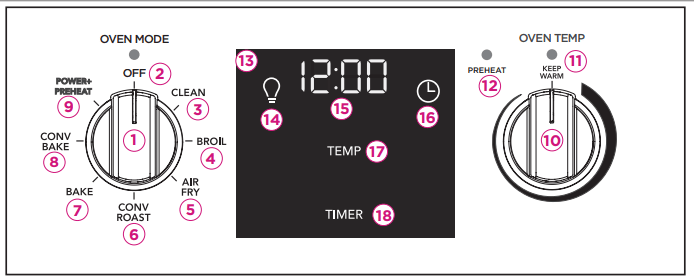
OVEN MODE SETTINGS
- OVEN MODE knob selects the cooking mode.
- OFF position turns the oven off and cancels all cooking.
- CLEAN mode begins a self-clean cycle.
- BROIL sears food with direct high heat. Use the + and - keys on the display to choose broil temp.
- AIR FRY quickly and evenly circulates heated air to deliver crispy, golden results with little to no oil.
- CONV ROAST uses a convection fan to gently brown meats and seal in the juices.
- BAKE is for foods that need heat to rise and move gently in the oven.
- CONV BAKE uses a fan to circulate the oven’s heat uniformly and continuously around the oven.
- POWER+ PREHEAT is best for single rack baking.
- OVEN TEMP knob selects the cooking temp for bake and convection cooking features. When turning the knob, the oven temperature is shown in the display.
- KEEP WARM is the lowest oven temp setting, designed to keep cooked foods at serving temps.
- PREHEAT light glows when the oven is first turned on, and turns off when the oven is preheated and ready to start cooking.
- DISPLAY is used to set advanced features and shows the time, temp, active cooking feature, and the timer. Interactive buttons appear in the display when setting different cooking features.
- OVEN LIGHT key turns the oven light on and off.
- CLOCK shows the time of day.
- CLOCK key is used to set the time of day in the display.
- TEMP area of the display shows the current oven temp.
- TIMER is used to set or cancel the minute timer.
NOTE: CLEAN and BROIL do not use the oven temperature knob. Both have their own default setting.
OVEN TEMP SETTINGS
Set the oven mode to OFF when finished cooking.
When setting oven temperatures use the OVEN TEMP knob for temperatures between 170°F (KEEP WARM) and 550°F. The CLEAN setting should only be used after reading all cautions and warnings.
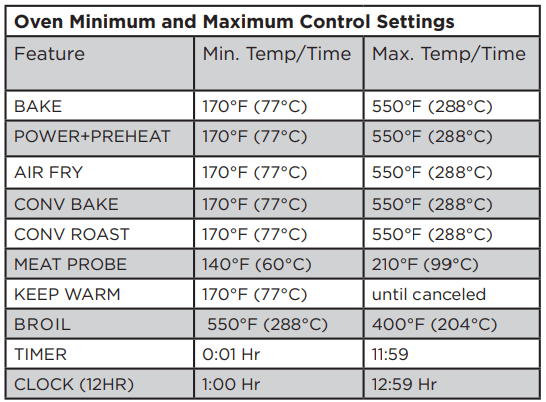
UPO (User Programmable Offset)
The default (factory) settings for sounds, energy saving, temperature offset, and convection convert are pre-set in the oven control. These may be changed by accessing the user preference display while the oven is in the idle mode and no timers are active. Once the user preference menu is activated, the user can make changes and scroll through a menu of options, choosing from AUd (audible control setting), ES (energy saving), UPO (User Programmable Offset for changing the oven temperature), and rSt reset choice (which will allow all preferences to reset to default settings).
Setting the Clock
The clock icon is used to access the time of day setting. When the oven is first plugged in or if there has been an interruption in power to the range, 12:00 will flash in the display
To set the correct time of day:
1. Press the clock icon.
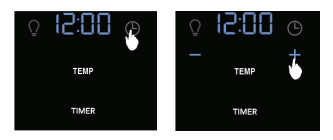
2. The display will show a time along with a – and a + key in the display below.
3. Press either – or + key to scroll to the correct time of day and release the key.
4. The control will accept the new set time with a tone, and the control will show the time of day along with the timer that is available.
NOTE The clock cannot be changed when the oven is set for cooking or self clean is active. Only a 12 hour clock is available on the Frigidaire Professional model.
Oven Light
The oven light will turn on automatically when the oven door is opened. The oven light may be turned on when the door is closed by using the oven light key located on the control panel.
NOTE: Keep oven light off while baking. The oven light will turn off during a clean cycle and not operate.
To toggle the oven lights on and off:
1. Press oven light symbol 
The interior oven light is covered with a glass shield. The glass shield must be in place whenever the oven is in use.
Setting the Timer
The minute timer in the oven display serves to help keep track of cooking functions. The timer cannot be used during a self clean cycle or if the meat probe function associated with the timer display is in use. The minimum timer setting is 1 minute and the maximum setting is 11:59 (HR:MIN).
To set the timer:
1. Press TIMER key
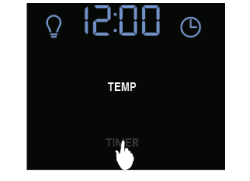
2. The timer display will show 0:00 and the – and + keys on either side of the time display. NOTE: If the – key is pressed at this time an invalid key tone will sound.

3. Press the + key to begin to scroll to the desired setting. If the + key is held, the timer value will increase rapidly. Once the desired setting is reached, release the key and the timer will start counting down automatically after a few seconds.
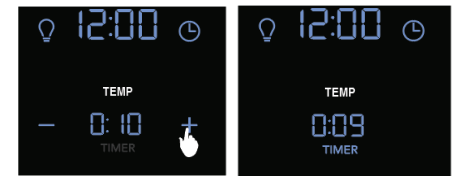
4. The timer display will show the H:M icon if the timer is set for more than 1 minute. If the value is under 1 minute, the timer will display the time in seconds and the H:M icon will not appear.
5. When the timer ends, a reminder tone will sound and repeat once every 60 seconds for a period of five minutes. Before the user can program an expired timer again, the timer key must be pressed.
6. To cancel the timer before the set time expires, press the TIMER key.
NOTE The minute timer will not start or stop the cooking process. The minute timer can be used alone or while using most of the other oven features
Continuous Bake or 12 Hour Energy Saving
The oven is preset to cook up to 12 hours and to shut off automatically. For longer periods of cooking, this feature can be changed to continuous cooking by setting the user preference and turning the energy saving feature off.
To set the oven for continuous cooking:
1. Press and hold both the light icon and the clock icon at the same time for a few seconds until the display sounds an acceptance chime and the display will show one of the user preferences.
2. Press the + key in the upper part of the display until ES appears and ON is showing.

Energy saving with ON and OFF options
1. To turn the energy saving feature off, press the + or – key in the lower part of the display and OFF will appear in the display.
2. The control will accept the change in a few seconds and sound the acceptance chime. The oven is now set for continuous cooking.
3. To return to the time of day display, press and hold the light and clock icons at the same time for a few seconds until the display chimes and fades back to showing the time of day in the display.
NOTE Changing to continuous bake does not change how the cooktop controls operate.
Setting Control for Silent Operation
The oven is set to operate with certain chimes and tones (default settings) that alert the user to certain oven functions. The silent operation feature allows the oven control to be operated without sounds when necessary. By accessing user preferences, this option can be later returned to operate with normal programming sounds.
To set the oven control for silent operation:
1. Press and hold both the light icon and the clock icon at the same time for a few seconds until the display sounds an acceptance chime. AUd should appear in the display.
2. If Aud is not showing, press the + key in the upper part of the display until AUd appears and HI is showing in the lower part of the display. This is the normal (default) setting.
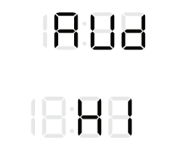
Default setting for oven control sounds
To turn the energy saving feature to a lower sound or completely OFF.
1. Press the + or – key in the lower part of the display until LO or OFF appears in the display.
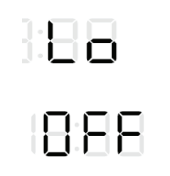
2. When the desired setting appears in the display, release the key and wait for an acceptance chime.
3. To return to the time of day display, press and hold both the light and clock icons at the same time for a few seconds until the display chimes and fades back to showing the time of day.
Power+ Preheat
Power+ Preheat is available for single rack baking with packaged and convenience foods and can be programmed for temperatures between 170°F and 550°F. Follow the recipe or package directions for food preparation time and temperature. When quick preheat is complete, a reminder tone will sound and food should be placed in the oven.
During power+ preheat, the bake burner will cycle on and off. The convection fan will turn on and stay on until power preheat is canceled. Depending on your preference for doneness cooking times may vary. Watch food closely.
Important:
- Always place food in center of the oven on rack position 4 (Figure 11). Place the food as shown in Figure 10.
- For best results when baking batter and doughbased items such as cookies and pastries, use convection bake function and place food in oven when the reminder tone sounds signaling the oven is fully preheated.
- Food may need to be removed early and should be checked at minimum recommended bake time.
To set the preheat temperature for 350°F:
1. Arrange the interior oven racks.
2. Turn OVEN MODE knob to POWER+ PREHEAT. The oven mode light will turn on.
3. Adjust the OVEN TEMP knob until the Oven Display shows the temperature setting of 350°F.
4. The oven temperature light will blink and an acceptance tone will sound.
5. The convection fan will turn on and remain on as a convection bake. The preheat light will stay on until preheating is finished.
6. Once the set temperature is reached the control will emit a tone alerting the user that the oven is preheated.
7. When finished baking turn oven mode to the OFF position.
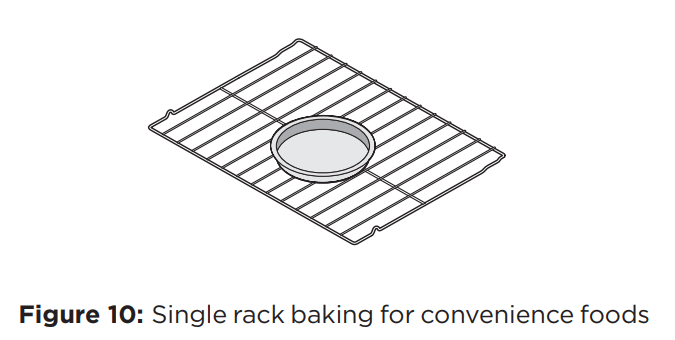
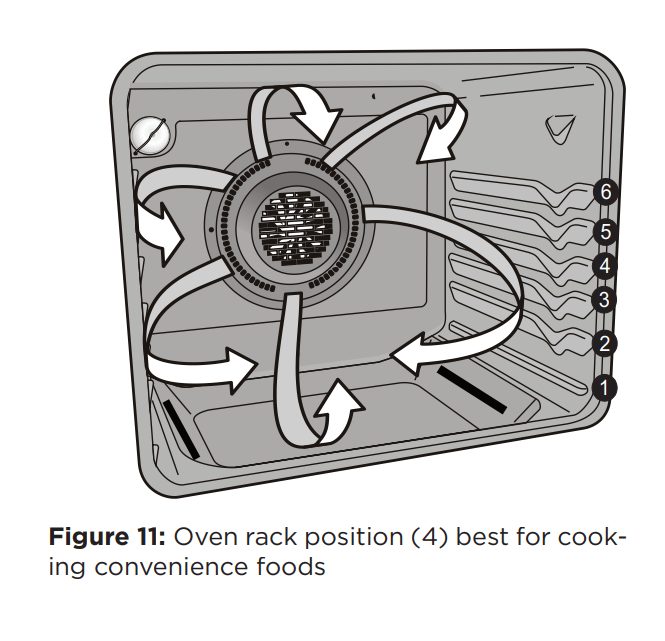
Setting Bake
Bake cooks with heat that rises from the oven bottom. The heat and air circulate naturally in the oven. A reminder tone will sound indicating when the set bake temperature is reached and to place the food in the oven. Bake may be set for any oven temperature between 170°F (77°C) to 550°F (288°C).
Baking Tips
- Fully preheat the oven before baking items like cookies, cakes, biscuits and breads.
- Use the convection bake function for best results when baking cookies on multiple racks.
- Bake is the best function to use for baking cakes.
- When using any single rack for baking cookies, cakes, biscuits, or muffins use rack position 4.
- Allow at least 2 inches (5 cm) of space between bakeware for proper air circulation.
- Do not open the oven door often. Doing so will reduce the temperature in the oven and may increase the cooking time necessary for best results.
- Do not leave the oven light on while baking.
To set Bake for oven temperature of 350°F:
1. Be sure to arrange racks to the desired positions for the item(s) to be baked.
2. Turn the OVEN MODE knob to BAKE.
3. Adjust the OVEN TEMP knob until the Oven Display shows the temperature setting of 350°F.
4. The PREHEAT light and the oven temperature light will turn on and sound an acceptance tone. The oven will begin heating.
5. When set temperature is reached the PREHEAT light will turn off and a reminder tone will sound alerting you to place food in oven. Set the timer to keep track of actual cooking time if necessary.
6. When finished baking, be sure to turn the OVEN MODE knob to the OFF position.
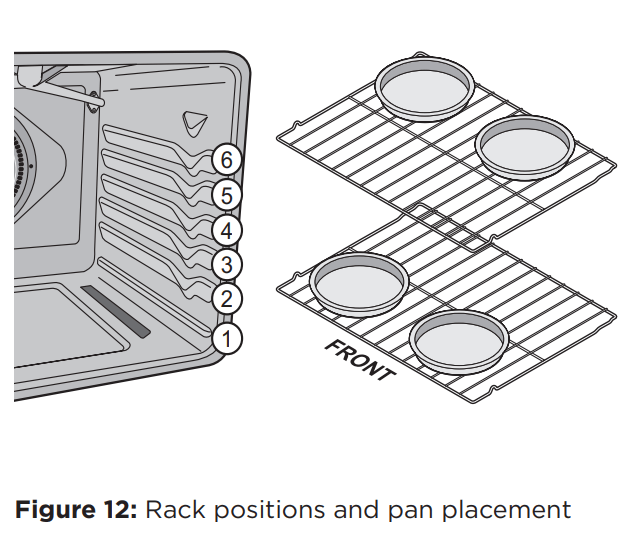
Air Fry
The Air Fry feature works best for single rack baking with packaged and convenience foods and can be programmed for temperatures between 170°F and 550°F. Follow the recipe or package directions for food preparation quantity, time, and temperature.
Important:
- Air Fry is designed for baking on a single oven rack. Food should be arranged in single layers on the tray.
- When using Air Fry, place a baking sheet on the rack position 1 to catch any crumbs or drippings to prevent these from burning on the oven bottom and creating smoke.
- When cooking fresh, homemade foods you may need to spray a little oil on the items.
- Leave oven light off when baking.
- Food may need to be removed early and should be checked at minimum recommended bake time. However, frozen dense foods and items with cook times less than 15 minutes may require additional time.
To set the Air Fry function:
1. Arrange food on Air Fry tray as suggested.
2. Select Air Fry. Adjust the OVEN TEMP knob until the Oven Display shows the desired temperature setting..
3. When preheat tone sounds place the Air Fry tray on rack position 4. Place the cWe certaiookie sheet on rack position 1.
4. Set Cook Time or minute timer for minimum suggested cook time listed in the table below and check food for desired doneness when cooking ends or timer ends and emits tones.
5. When cooking is complete turn OVEN MODE knob to OFF.
Frigidaire's Air Fry Tray is specifically designed to deliver superior performance.
Some Benefits Air Fry Tray:
- Tray optimized for oven space.
- Fits in the dishwasher for easy clean up.
- Higher yield than countertop models.
- Frees up countertop space
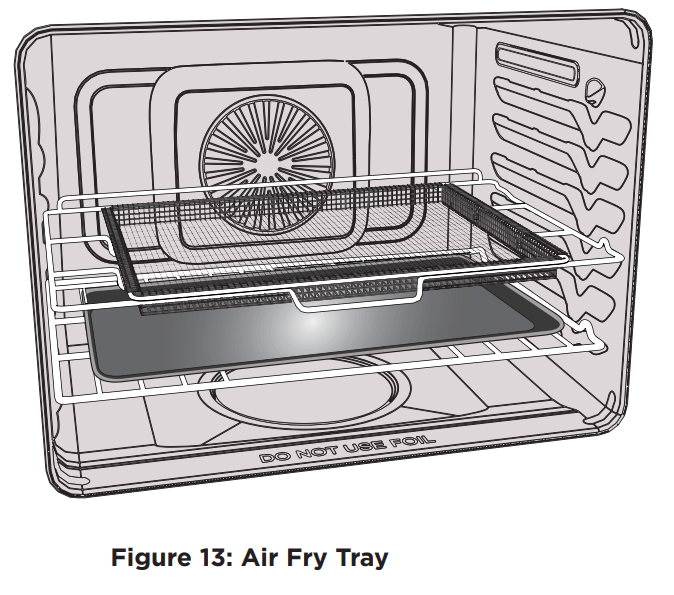
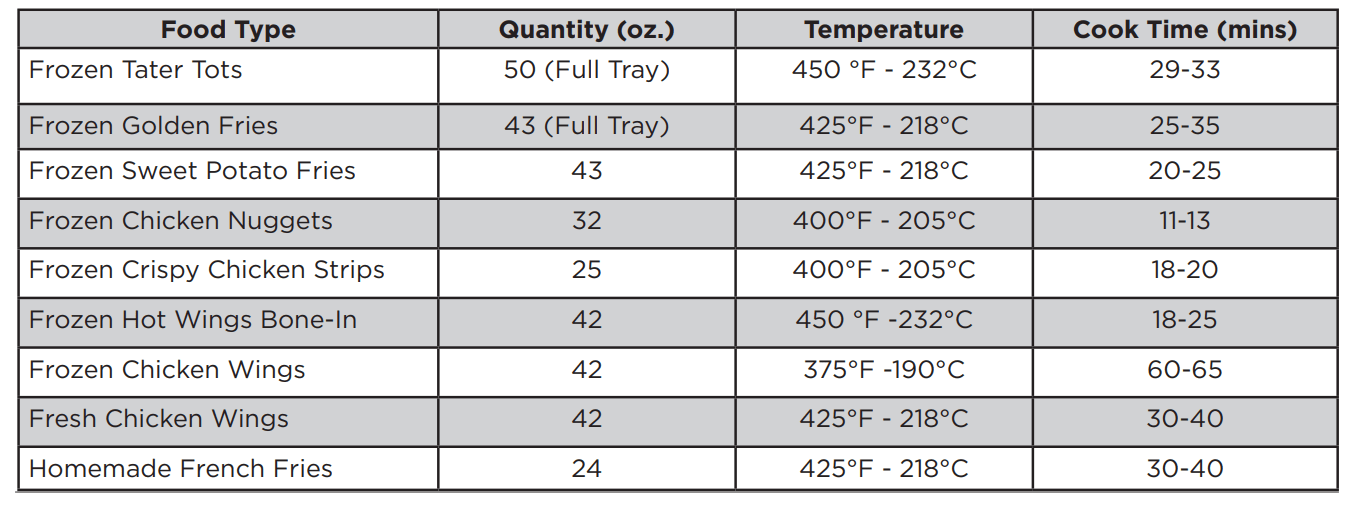 CARE AND CLEANING
CARE AND CLEANING
Remove spills and any heavy soiling as soon as possible. Regular cleaning will reduce the difficulty of major cleaning later.
CAUTION
Before cleaning any part of the appliance, be sure all controls are turned off and the appliance is cool. If ammonia or appliance cleaners are used, they must be removed and the appliance must be thoroughly rinsed before operating. Follow manufacturer’s instructions and provide adequate ventilation.
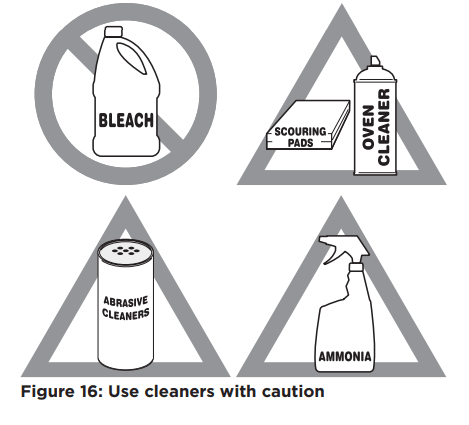
|
Surface or Area |
Cleaning Recommendation |
|
Porcelain-enameled broiler pan and insert Porcelain door liner Porcelain body parts |
Rinse with clean water and a damp cloth. Scrub gently with a soapy, non-abrasive scouring pad to remove most spots. Rinse with a 50/50 solution of clean water and ammonia. If necessary, cover difficult spots with an ammonia-soaked paper towel for 30 to 40 minutes. Rinse and wipe dry with a clean cloth. Remove all cleaners or future heating could damage the porcelain. Do not allow food spills with a high sugar or acid content (milk, tomatoes, sauerkraut, fruit juices or pie filling) to remain on porcelain surfaces. These spills may cause a dull spot even after cleaning. |
| Manual clean oven interior | The oven interior is porcelain coated and safe to clean using oven cleaners. Always follow manufacturer's instructions for cleaners. After cleaning, remove any oven cleaner or the porcelain may become damaged during future heating. Do not spray oven cleaner on any electrical controls or switches. Do not spray or allow oven cleaner to build up on the oven temperature sensing probe. Do not spray cleaner on oven door trim, door gasket, plastic drawer glides, handles or any exterior surfaces of the appliance. |
| Self-cleaning oven interior | Before setting a self-clean cycle, clean soils from the oven frame, areas outside the oven door gasket, and the small area at the front center of the oven bottom. See “Self Clean” on page 38 |
| Oven door |
Use mild dish detergent and water or a 50/50 solution of vinegar and water to clean the top, sides, and front of the oven door. Rinse well. Glass cleaner may be used on the outside glass of the door. Ceramic smoothtop cleaner or polish may be used on the interior door glass. Do not immerse the door in water. Do not spray or allow water or cleaners to enter the door vents. Do not use oven cleaners, cleaning powders, or any harsh abrasive cleaning materials on the outside of the oven door. Do not clean the oven door gasket. The oven door gasket is made of a woven material which is essential for a good seal. Do not rub, damage, or remove this gasket. |
| Gas cooktop surface burners | See “Cleaning the sealed oval burners” on page 42. |
|
Gas cooktop surface grates Gas cooktop burner caps |
Use a non-abrasive plastic scrubbing pad and mild abrasive cleanser. Do not allow food spills with a high sugar or acid content (milk, tomatoes, sauerkraut, fruit juices or pie filling) to remain on the burner grates or burner caps. These spills may cause a dull spot even after cleaning. Clean these spills as soon as surfaces are cool. Thoroughly dry immediately following cleaning. |
| Aluminum and vinyl | Using a soft cloth, clean with mild dish detergent and water. Rinse with clean water, dry and polish with a soft, clean cloth. |
|
Painted and plastic control knobs Painted body parts Painted decorative trims |
Using a soft cloth, clean with mild dish detergent and water or a 50/50 solution of vinegar and water. Rinse with clean water, dry and polish with a soft, clean cloth. Glass cleaners may be used, but do not apply directly to surface; spray onto cloth and wipe. |
| Control panel | Using a soft cloth, clean with mild dish detergent and water or a 50/50 solution of vinegar and water. Do not spray liquids directly on the oven control and display area. Do not use large amounts of water on the control panel - excess water on the control area may cause damage to the appliance. Do not use other liquid cleaners, abrasive cleaners, scouring pads, or paper towels - they will damage the finish. |
| Control knobs | Using a soft cloth, clean with mild dish detergent and water or a 50/50 solution of vinegar and water. To remove control knobs: turn to the OFF position, grasp firmly, and pull off the shaft. To replace knobs after cleaning, line up the OFF markings and push the knobs into place. |
| Stainless Steel | Using a soft cloth, clean with mild dish detergent and water or a 50/50 solution of vinegar and water. Rinse with clean water, dry with a soft clean cloth. Do not use cleaners containing abrasives, chlorides, chlorine, or ammonia. |
| Smudge Proof™ Stainless Steel Black Stainless | Steel Using a soft cloth, clean with mild dish detergent and water or a 50/50 solution of vinegar and water. Rinse with clean water, dry with a soft clean cloth. Do not use appliance cleaner, stainless steel cleaner, or cleaner containing abrasives, chlorides, chlorine, or ammonia. These cleaners may damage the finish. |
Aluminum Foil and Utensils
WARNING
Never cover any slots, holes, or passages in the oven bottom or cover an entire oven rack with materials such as aluminum foil. Aluminum foil linings may trap heat, causing a fire hazard.
Protective Liners — Do not use aluminum foil to line the oven bottom. Improper installation of these liners may result in risk of electric shock or fire.
CAUTION
Aluminum foil - Use of aluminum foil on a hot cooktop can damage the cooktop. Do not use thin aluminum cooking utensils or allow aluminum foil to touch the surface burners under any circumstances.
Aluminum utensils - The melting point of aluminum is much lower than that of other metals. Care must be taken when aluminum pots or pans are used on the cooktop. If aluminum pans are allowed to boil dry when using the cooktop, not only will the utensil be damaged or destroyed, but it may fuse to, break, or mark thesurface burners, permanently damaging the cooktop surface.
Cleaning the sealed oval burners
To avoid possible burns, do not attempt cleaning before turning off all surface burners and allowing them to cool.
Any additions, changes, or conversions required in order for this appliance to satisfactorily meet the application needs must be made by an authorized qualified Agency. Routinely clean the cooktop. Wipe with a clean, damp cloth and wipe dry to avoid scratches. Keeping the surface burner head ports and slots clean will prevent improper ignition and an uneven flame.
To clean recessed and contoured areas of cooktop:
- If a spill occurs on or in the recessed or contoured areas, blot up spill with an absorbent cloth.
- Rinse with a clean, damp cloth and wipe dry
CAUTION
To avoid possible burns do not attempt to operate the surface burners without the burner caps. Do not use spray oven cleaner on the cooktop.
To clean oval burner heads:
1. Remove the burner cap from the burner head. Clean the cap with hot soapy water and dry thoroughly

2. For burned-on and dried spills, apply hot soapy water to the burner head. Allow time for the soils to soften.
3. Use a toothbrush to clean all over the burner head and the slots and holes in the burner (see Figure 17).
4. Use a needle or fine wire to clean out the ignition port (see Figure 17).
5. Wipe the burner head clean with a soft, clean cloth, sponge, or scratch-free cleaning pad.
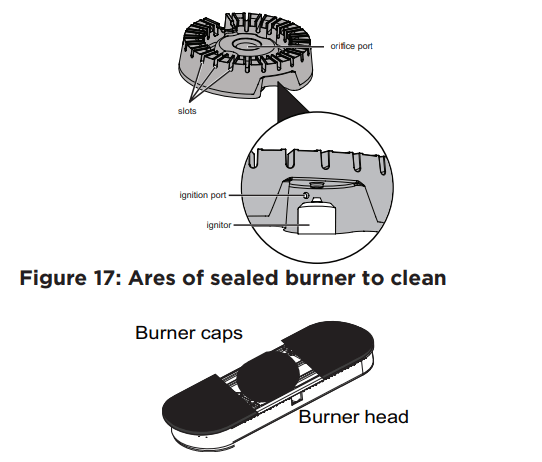
6. Before using the cooktop again, make sure the burner caps are properly placed and seated on the burner heads. When placed correctly, the burner cap is centered on the burner head and will click into place on the burner head. You can wiggle the cap to test placement, it should not move off the burner head (see”Assembly of the Burner Caps” on page 13).
Important notes:
- The surface burner heads are secured to the cooktop and must be cleaned in place on the cooktop.
- Always keep the surface burner caps in place whenever a surface burner is in use.
- When replacing the burner caps, be sure the burner caps are seated firmly on top of the burner heads.
- For proper flow of gas and ignition of burners do not allow spills, food, cleaning agents, or any other material to enter the gas orifice port opening.
Cleaning burners with removable heads
To clean burner heads:
1. Remove the burner cap and burner head carefully.
2. Clean the cap and head with hot soapy water and let dry thoroughly.
3. For burned on and dried spills, apply hot soapy water to the burner cap and head and let soak for the soils to soften. Use a toothbrush to clean all over the burner head.

4. Wipe the burner cap and head clean with a soft, clean cloth, sponge, or scratch free cleaning pad.
5. Before using the cooktop again, make sure the burner caps and heads are properly placed and seated properly over the igniter. When placed correctly, the burner cap is centered on the burner head and will click into place on the burner head. You can wiggle the cap to test placement, it should not move off the burner head.
Removing the Storage Drawer
Use the storage drawer for storing cooking utensils. The drawer can be removed to facilitate cleaning under the range. Use care when handling the drawer.
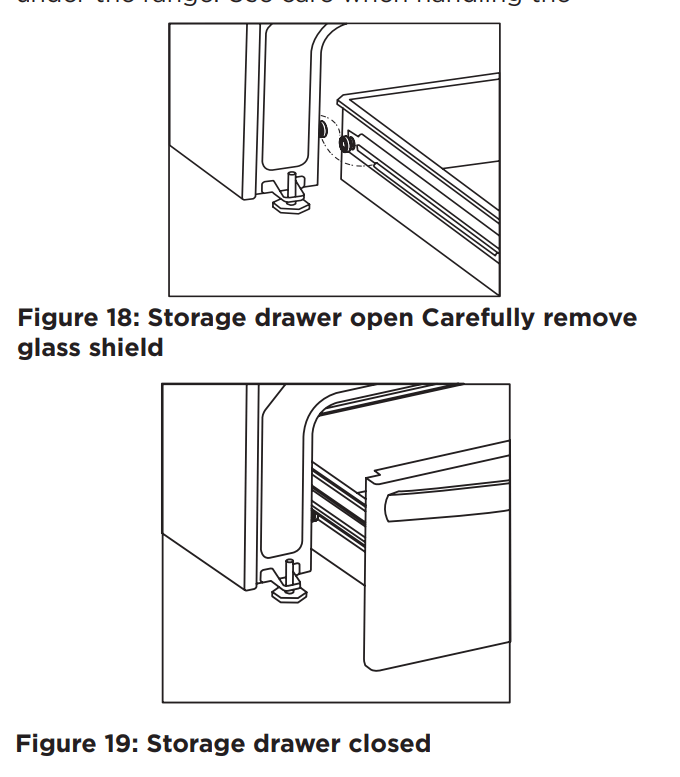
Replacing the oven lights
CAUTION Be sure the range is unplugged and all parts are COOL before replacing oven light. Wear a leather-faced glove for protection against possible broken glass or burns.
The oven light bulbs are located at the rear of the oven cavity and both are covered with a glass shield. The glass shield must be in place whenever the oven is in use.
Replacing the interior light bulbs:
1. Turn electrical power off at the main source or unplug the range.
2. Remove carefully oven interior light shield as illustrated below.
3. Replace bulb with a new T-4 type 25 Watt Halogen appliance bulb. Please note: Do not allow your fingers to touch the new bulb when replacing. This will shorten the life of the new bulb. Use a paper towel to cover the new bulb when installing.
4. Replace glass shield over bulb.
5. Turn power back on again at the main source (or plug the range back in).
6. The clock will then need to be reset.
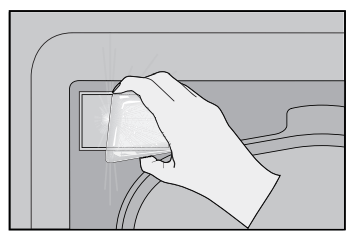
Figure 20: Carefully remove glass shield
Caring for Your Glide Racks
Caution: Handle oven racks only when they are cool. After cooking or after the clean cycle, racks will be very hot and can cause burns.
Important Notes:
- Remove all oven racks, including ladder racks, before starting a clean cycle.
- Do not use cooking oil, cooking spray, or other oil-based lubrication products on the glide rack extension tracks. Use only the graphite lubrication in this area. To order graphite lubrication, contact your installer, servicer or dealer.
- It is important that the parts of the rack that contact the oven sides always have a light coating of vegetable oil. Apply a thin layer of vegetable oil to the sides of the rack after every clean cycle and when the rack becomes difficult to reposition in the oven.
To lubricate the glide rack:
1. Remove the rack from the oven and place the rack on a large flat surface covered with newspaper or scrap cloth. Fully extend the rack.
2. Wipe away debris and crumbs from the glide track using a cloth or sponge.
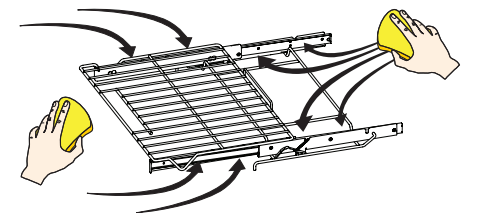
3. Shake graphite lubrication very well before applying. Apply to loading guides, and rotation pin. Repeat on both sides of the glide rack.
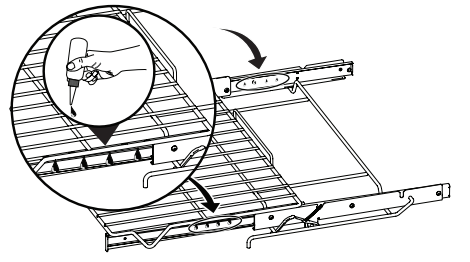
4. Extend and return the glide rack several times along the tracks to distribute the lubrication.
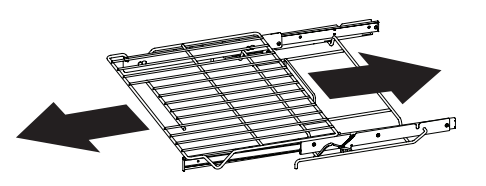
5. Turn the rack upside down and apply graphite lubrication to the insides of the loading guides.

6. Extend and return the glide rack several times along the tracks to distribute the lubrication.
7. Apply a thin layer of cooking oil to the bottom of the “V” and the glide channels. Keeping the frame sides lightly lubricated allows the entire rack to slide easily when changing rack positions.

8. Replace rack in oven right-side up.
Removing and Replacing the Oven Door
CAUTION The door is heavy. To temporarily store it safely, place the door horizontally with the interior side facing down.
To remove the oven door:
1. Open oven door completely, horizontal with floor.
2. Pull up the lock located on each hinge support toward front of the oven until the lock stops. You may have to apply a little upward pressure on the lock to pull it up (Figure 22 and Figure 23).
3. Grasp the door by the sides, and close the door until the door frame makes contact with the unlocked hinges.
4. Pull the bottom of the door toward you while rotating the top of the door toward the appli- ance to completely disengage the hinge levers (Figure 24).
To Replace Oven Door:
1. Firmly grasp both sides of oven door along the door sides. Do not use the oven door handle (Figure 24).
2. Hold the oven door at the same angle as the removal position. Carefully insert the hinge levers into the oven frame until you feel the hinge levers are seated into the hinge notches. The hinge arms must be fully seated into the hinge notches before the oven door can be fully opened. (Figure 24.
3. Fully open the oven door, horizontal with floor (Figure 21).
4. Push the door hinge locks up toward and into the oven frame on both left and right oven door hinges to the locked position (Figure 22 and 23).
5. Close the oven door.
IMPORTANT
Special door care instructions - The door is heavy. For safe, temporary storage, lay the door flat with the inside of the door facing down. Most oven doors contain glass that can break. Do not close the oven door until all the oven racks are positioned correctly in the cavity. Do not hit the glass with bakeware or any other objects. Scratching, hitting, jarring, or stressing the glass may weaken its structure, causing an increased risk of breakage at a later time
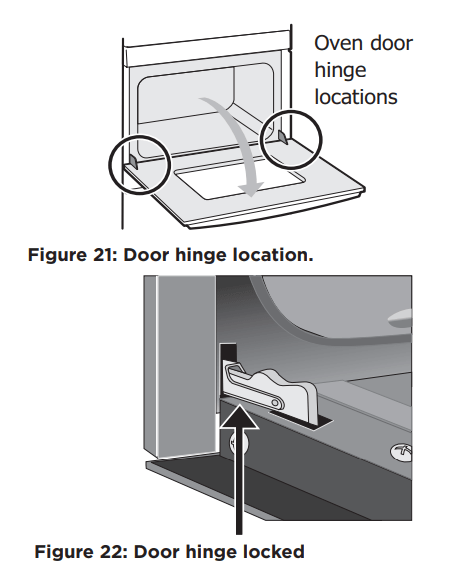
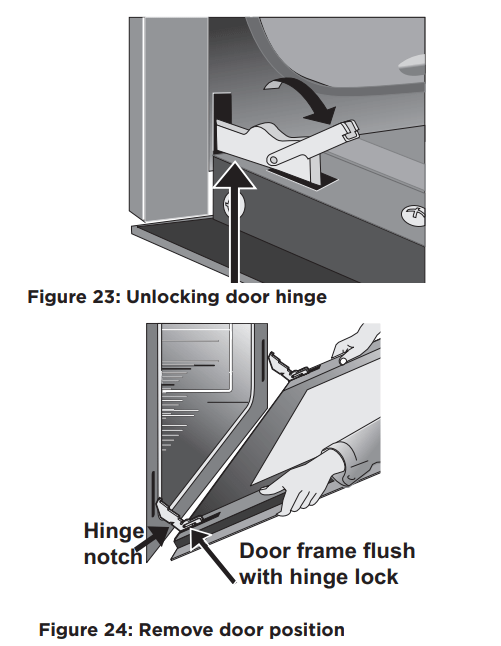
BEFORE YOU CALL
Oven Baking
For best cooking results, preheat the oven before baking cookies, breads, cakes, pies, pastries, etc. There is no need to preheat the oven for roasting meat or baking casseroles. The cooking times and temperatures needed to bake a product may vary slightly from your previously owned appliance.
| Baking Problems and Solutions Baking Problems | ||
|
Baking Problems |
Causes |
Corrections |
|
Cookies and biscuits burn on the bottom.
|
Cookies and biscuits put into oven before oven is preheated. | Allow oven to preheat to desired temperature before placing food in oven. Choose pan sizes that will permit at least 2” of air space |
|
Cakes too dark on top or bottom
|
Cakes put in oven before oven is preheated. Rack position too high or too low. Oven too hot. |
Allow oven to preheat to the selected temperature before placing food in the oven. Use proper rack position for baking needs. Set oven temperature 25°F (13°C) lower than recommended. |
|
Cakes not done in center
|
Oven too hot. Incorrect pan size. Pan not centered in oven. Glass cookware slow heat conductor. |
Set oven temperature 25°F (13°C) lower than recommended. Use pan size suggested in recipe. Use proper rack position and place pan so there are at least 2” (5.1 cm) of space on all sides of pan. Reduce temperature and increase cook time or use shiny bakeware. |
|
Cakes not level.
|
Oven not level. Pan too close to oven wall or rack overcrowded. Pan warped. Oven light left on while baking. |
Place a marked glass measuring cup filled with water on the center of the oven rack. If the water level is uneven, refer to the installation instructions for leveling the oven. Use proper rack position and place pan so there are at least 2” (5.1 cm) of space on all sides of pan. Do not use pans that are dented or warped. Do not leave the oven light on while baking. |
|
Foods not done when cooking time is over.
|
Oven too cool. Oven overcrowded. Oven door opened too frequently. |
Set oven temperature 25°F (13°C) higher than suggested and bake for the recommended time. Be sure to remove all pans from the oven except the ones to be used for baking. Open oven door only after the shortest recommended baking time. |
( Problem – Cause / Solution )
| Entire appliance does not operate |
Appliance not connected. Make sure power cord is plugged properly into outlet. Check your fuse box or breaker box to make sure the circuit is active. Electrical power outage. Check house lights to be sure. Call your local electric company for service outage information. |
| Oven Problems | |
| Poor baking results. | Many factors affect baking results. Use proper oven rack position. Center food in the oven and space pans to allow air to circulate. Preheat the oven to the set temperature before placing food in the oven. Try adjusting the recipe's recommended temperature or baking time. See “Adjusting the Oven Temperature” on page 37 if you feel the oven is too hot or too cool. |
| Flames inside oven or smoking from oven vent. | Excessive spills in oven. Grease or food spilled onto the oven bottom or oven cavity. Wipe up excessive spills before starting the oven. If flames or excessive smoke are present when using broil, see “Using the Broil Feature” on page 30 |
| Oven smokes excessively when broiling. |
Incorrect setting. Follow the “Using the Broil Feature” on page 30 Meat too close to the broil element or burner. Reposition the broil pan to provide proper clearance between the meat and broil element or burner. Remove excess fat from meat. Cut remaining fatty edges to prevent curling, but do not cut into lean. Grease build up on oven surfaces. Regular cleaning is necessary when broiling frequently. Grease or food splatters will cause excessive smoking. |
| Air Fry causing smoke | When using the air fry tray place a baking sheet on a rack below to catch any drippings and prevent them from causing smoke from the oven bottom. |
| Oven control panel beeps and displays any F or E code error. | Oven control has detected a fault or error condition. To clear the error, press the OFF key on the control panel. Once the error code is cleared, try the bake or broil function. If the F or E code error repeats, turn off the power to appliance, wait 5 minutes, and then repower the appliance. Set the clock with correct time of day. Try the bake or broil function again. If the fault recurs, press the OFF key to clear. |
| Oven portion of appliance does not operate. |
Be sure the regulator gas valve is turned to ON. See installation instructions. The time of day is not set. The clock must be set in order to operate the oven. See ”Setting the Clock” on page 22. Be sure the oven controls are set properly for the desired function. See “OVEN MODE SETTINGS” on page 21 and review instructions for the desired cooking function in this manual or see “Entire appliance does not operate.” in this checklist. |
| Convection fan does not rotate. |
Oven door is open. The convection fan will turn off if the oven door is opened when convection is active. Close the oven door. On gas models, the convection fan will begin to rotate about 6 minutes into the preheating process. |
| Cooktop Problems | |
| Surface burners do not ignite. |
Surface control knob was not completely turned to LITE (). Push in and turn the surface control knob to LITE until the burner ignites and then turn the control knob to the desired flame size. Burner ports are clogged. With the burner OFF and cool, use a small-gauge wire or needle to clean the burner head slots and ignition ports. See “Cleaning burners with removable heads” on page 42 for additional cleaning instructions. Range power cord is disconnected from outlet (electric ignition models only). Be sure the power cord is securely plugged into the power outlet. Circuit is broken. Check breaker box or fuse box. Electrical power outage. Burners may be lit manually. See “Setting surface controls” on page 16. |
| Surface burner flame uneven or only part way around burner cap. |
Burner slots or ports are clogged. With the surface burner OFF and cool, clean ports with a small-gauge wire or needle. If moisture is present after cleaning, lightly fan the flame and allow the burner to operate until flame is full. Burner caps are not seated properly. Check that all burner caps are level and seated correctly on the burner heads. See “Cleaning burners with removable heads” on page 42 for additional cleaning instructions. |
| Surface burner flame is too high. |
Surface control knob is set too high. Adjust to a lower flame setting. Burner caps are not seated properly. Check that all surface burner caps are level and seated correctly on the surface burner heads. See “Cleaning burners with removable heads” on page 42 for additional cleaning instructions. Incorrect L.P. conversion. Refer to L.P. conversion kit instructions to correct. |
| Surface burner flame is orange. |
Dust particles in main gas line. Allow the burner to operate a few minutes until flame turns blue. In coastal areas, a slightly orange flame is unavoidable due to salt content in the air. Incorrect L.P. conversion. Refer to L.P. conversion kit instructions to correct. |
| Self clean does not work. | Oven control not set properly. See “Self Clean” on page 38 |
| Oven racks discolored or do not slide easily. | Oven racks left in oven cavity during self clean. Remove oven racks from oven cavity before starting a self-clean cycle. Clean by using a mild abrasive cleaner following manufacturer's instructions. Rinse with clean water, dry, and replace in oven. |
| Soil not completely removed after self clean. |
Self clean was interrupted. Review instructions on “Self Clean” on page 38 Excessive spills on oven bottom. Remove excessive spills before starting self clean. Failure to clean soil from the oven frame, the door liner outside the oven door gasket, and the small area at the front center of the oven bottom. These areas are not in the self-cleaning area, but get hot enough to burn on residue. Clean these areas before starting the self-cleaning cycle. Burned-on residue can be cleaned with a stiff nylon brush and water or a nylon scrubber. Be careful not to damage the oven gasket. |
| The oven control display shows "SCC" and selfclean is not working. | The cooktop should not be used during a self-clean cycle. On some models, turning on any cooktop surface burner will cause the clean cycle to cancel. If the clean cycle is canceled, the oven control display will show “SCC" for 5 seconds. The oven door will remain locked until the oven has cooled down below cleaning temperature. If the oven is below cleaning temperature, the user can start another clean cycle immediately. If the oven is in cleaning temperature range, another self-clean cycle can be set once the door unlocks (up to 4 hours). |
| Other Problems | |
| Appliance is not level. |
Be sure the floor is level, strong, and stable enough to adequately support the range. If the floor is sagging or sloping, contact a carpenter to correct the situation. Poor installation. Place the oven rack in the center of the oven. Place a level on the oven rack. Adjust the leveling legs at the base of the appliance until the rack is level. Kitchen cabinet alignment may make range appear not level. Be sure cabinets are square and have sufficient room for appliance clearance. |
| Cannot move appliance easily. Appliance must be accessible for service. |
Cabinets not square or are built in too tightly. Contact the builder or installer to make the appliance accessible. Carpet interferes with appliance. Provide sufficient space so the appliance can be lifted over carpet. Installation over carpet is not advised. See the installation instructions for guidelines specific to your appliance. |
| Oven light does not work. | Be sure the oven light is secure in the socket. See “Replacing the interior light bulbs:” on page 43 |
See other models: FFGH3054UW GRSS2352AF FRSS2333AS FRSC2333AS FRSS2323AW





